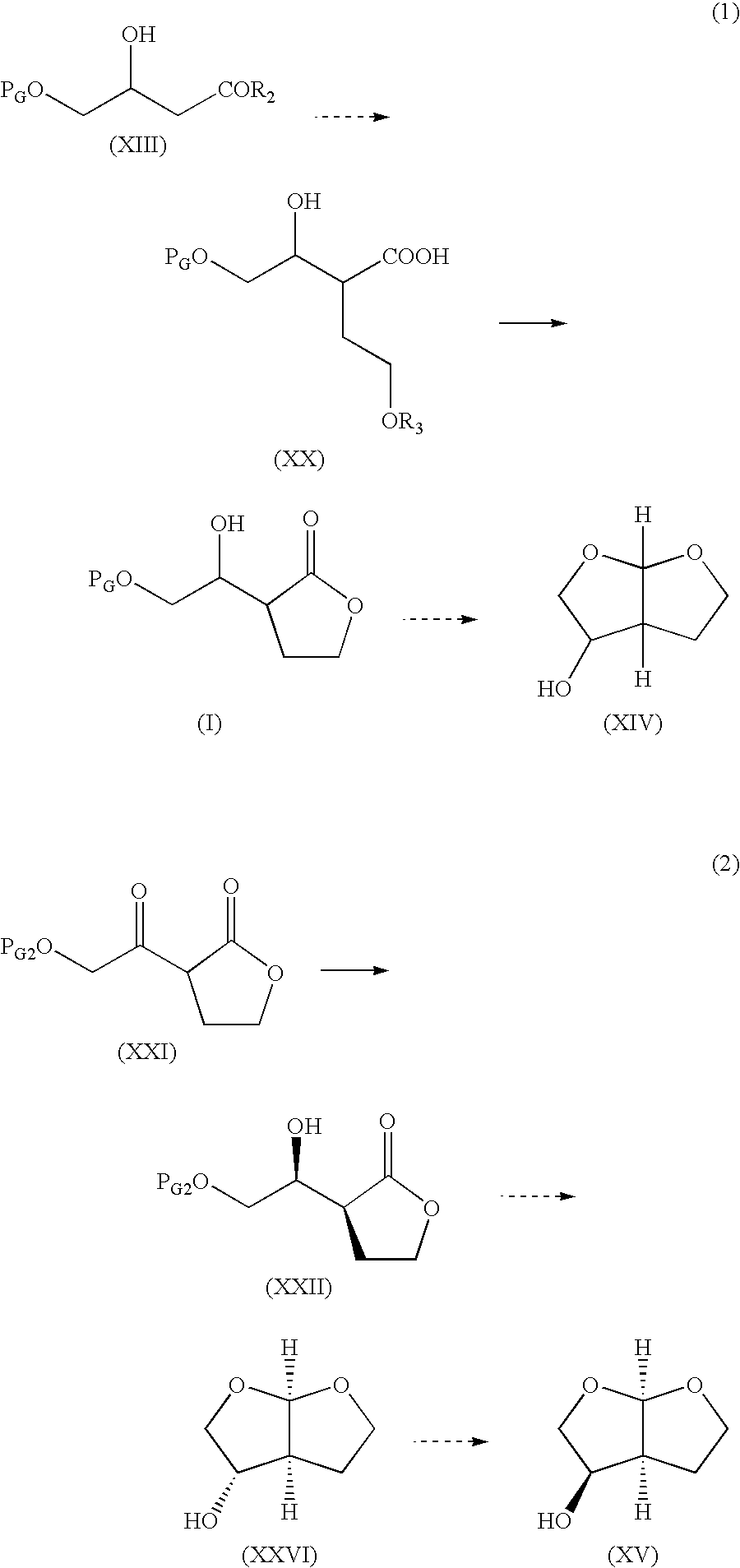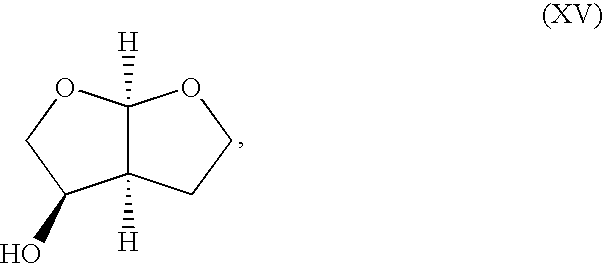Production method of hexahydrofurofuranol derivative, intermediate therefor and production method thereof
a technology of hexahydrofuranol and production method, applied in the field of hexahydrofuranol derivative, can solve the problems of high toxicity, high toxicity of selenium compound, ozone oxidation, etc., and achieve the effect of efficient and economical
- Summary
- Abstract
- Description
- Claims
- Application Information
AI Technical Summary
Benefits of technology
Problems solved by technology
Method used
Image
Examples
example 1
Synthesis of (1′R*,2S*)-2-[2′-(1,1-dimethylethoxy)-1′-hydroxyethyl]-4-butanolide
Compound Having a Relative Configuration Represented by the Formula (VII)
[0257]Ethyl 4-t-butoxyacetoacetate (20.0 g) synthesized according to the method described in Heterocycles 26, 2841 (1987) was dissolved in methanol (150 mL) and sodium borohydride (1.68 g) was added at a temperature of from 5° C. to 15° C. The mixture was stirred for 1 hr and water (100 mL) was added. The solvent was mostly evaporated, and the organic layer extracted twice with MTBE (150 mL) was washed well with water. MTBE was evaporated to give ethyl (±)-4-t-butoxy-3-hydroxybutanoate (16.9 g). To a solution of lithium diisopropylamide 1.5 M cyclohexane solution (73 mL) in THF (100 mL) was added a solution of ethyl (±)-4-t-butoxy-3-hydroxybutanoate (10.66 g) in THF (30 mL) at a temperature of from −58° C. to −48° C. and the temperature was raised to −20° C. Separately, 2-iodoethanol (21.5 g) and ethyl vinyl ether (11.4 g) were mixe...
example 2
Synthesis of (1′R*,2S*)-2-(1′,2′-dihydroxyethyl)-4-butanolide
Compound Having Relative Configuration Represented by the Formula (VIII)
[0259](1′R*,2S*)-2-[2′-(1,1-Dimethylethoxy)-1′-hydroxyethyl]-4-butanolide (1.3 g) was added to trifluoroacetic acid (4 mL) and the mixture was stirred on an ice bath for 90 min. Trifluoroacetic acid was evaporated under reduced pressure to give the title compound (1.0 g).
[0260]1H-NMR (CDCl3, δppm): 2.10-2.20 (1H, m), 2.37-2.44 (1H, m), 2.80-2.87 (1H, m), 3.6-3.8 (1H (—OH), br), 3.67 (1H, dd, J=12 Hz, J=6 Hz), 3.75 (1H, dd, J=12 Hz, J=3 Hz), 3.86-3.90 (1H, m), 4.24-4.30 (1H, m), 4.43 (1H, dt, J=9 Hz, J=3 Hz), 4.4-4.5 (1H (—OH), br).
example 3
Synthesis of (2S*,4′R*)-2-(2′,2′-dimethyl-[1′,3′]dioxolane-4′-yl)-4-butanolide
Compound Having Relative Configuration Represented by the Formula (IX)
[0261]2,2-Dimethoxypropane (15 mL) was added to (1′R*,2S*)-2-(1′,2′-dihydroxyethyl)-4-butanolide (1.0 g), p-toluenesulfonic acid monohydrate (50 mg) was added, and the mixture was stirred at room temperature for 2 hr. The reaction mixture was poured into saturated aqueous sodium hydrogen carbonate solution (100 mL), extracted twice with MTBE (50 mL). The organic layer was thoroughly washed with saturated aqueous sodium hydrogen carbonate solution, and the solvent was evaporated to give the title compound (0.75 g).
[0262]1H-NMR (CDCl3, δppm): 1.36 (3H, s), 1.42 (3H, s), 2.18-2.28 (1H, m), 2.37-2.47 (1H, m), 2.88-2.95 (1H, m), 3.97 (1H, dd, J=9 Hz, J=6 Hz), 4.08 (1H, dd, J=9 Hz, J=7 Hz), 4.19-4.36 (1H, m), 4.37-4.45 (1H, m), 4.45-4.49 (1H, m).
PUM
 Login to View More
Login to View More Abstract
Description
Claims
Application Information
 Login to View More
Login to View More - R&D
- Intellectual Property
- Life Sciences
- Materials
- Tech Scout
- Unparalleled Data Quality
- Higher Quality Content
- 60% Fewer Hallucinations
Browse by: Latest US Patents, China's latest patents, Technical Efficacy Thesaurus, Application Domain, Technology Topic, Popular Technical Reports.
© 2025 PatSnap. All rights reserved.Legal|Privacy policy|Modern Slavery Act Transparency Statement|Sitemap|About US| Contact US: help@patsnap.com



